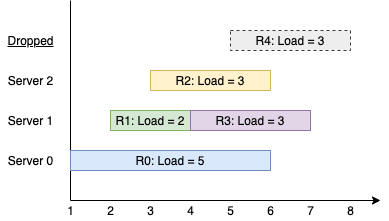2021-03-12 Daily-Challenge
Today I have done Find Servers That Handled Most Number of Requests and leetcode's March LeetCoding Challenge with cpp.
Find Servers That Handled Most Number of Requests
Description
You have k servers numbered from 0 to k-1 that are being used to handle multiple requests simultaneously. Each server has infinite computational capacity but cannot handle more than one request at a time. The requests are assigned to servers according to a specific algorithm:
- The
ith(0-indexed) request arrives. - If all servers are busy, the request is dropped (not handled at all).
- If the
(i % k)thserver is available, assign the request to that server. - Otherwise, assign the request to the next available server (wrapping around the list of servers and starting from 0 if necessary). For example, if the
ithserver is busy, try to assign the request to the(i+1)thserver, then the(i+2)thserver, and so on.
You are given a strictly increasing array arrival of positive integers, where arrival[i] represents the arrival time of the ith request, and another array load, where load[i] represents the load of the ith request (the time it takes to complete). Your goal is to find the busiest server(s). A server is considered busiest if it handled the most number of requests successfully among all the servers.
Return a list containing the IDs (0-indexed) of the busiest server(s). You may return the IDs in any order.
Example 1:

Input: k = 3, arrival = [1,2,3,4,5], load = [5,2,3,3,3]
Output: [1]
Explanation:
All of the servers start out available.
The first 3 requests are handled by the first 3 servers in order.
Request 3 comes in. Server 0 is busy, so it's assigned to the next available server, which is 1.
Request 4 comes in. It cannot be handled since all servers are busy, so it is dropped.
Servers 0 and 2 handled one request each, while server 1 handled two requests. Hence server 1 is the busiest server.
Example 2:
Input: k = 3, arrival = [1,2,3,4], load = [1,2,1,2]
Output: [0]
Explanation:
The first 3 requests are handled by first 3 servers.
Request 3 comes in. It is handled by server 0 since the server is available.
Server 0 handled two requests, while servers 1 and 2 handled one request each. Hence server 0 is the busiest server.
Example 3:
Input: k = 3, arrival = [1,2,3], load = [10,12,11]
Output: [0,1,2]
Explanation: Each server handles a single request, so they are all considered the busiest.
Example 4:
Input: k = 3, arrival = [1,2,3,4,8,9,10], load = [5,2,10,3,1,2,2]
Output: [1]
Example 5:
Input: k = 1, arrival = [1], load = [1]
Output: [0]
Constraints:
- $1 \le k \le 10^5$
- $1 \le arrival.length, load.length \le 10^5$
- $arrival.length == load.length$
- $1 \le arrival[i], load[i] \le 10^9$
arrivalis strictly increasing.
Solution
writing code on phone is not comfortable, but I finally managed to get AC at first time!
class Solution {
public:
vector<int> busiestServers(int k, vector<int>& arrival, vector<int>& load) {
using pii = pair<int, int>;
int len = arrival.size();
set<int> ok;
for(int i = 0; i < k; ++i) ok.insert(i);
priority_queue<pii, vector<pii>, greater<pii>> q;
vector<int> count(k);
for(int i = 0; i < len; ++i) {
while(!q.empty() && q.top().first <= arrival[i]) {
ok.insert(q.top().second);
q.pop();
}
if(ok.empty()) continue;
auto it = ok.lower_bound(i % k);
int pos = (it == ok.end() ? *(ok.begin()) : *it);
ok.erase(pos);
q.push(make_pair(arrival[i] + load[i], pos));
count[pos] += 1;
}
int mmax = *max_element(count.begin(), count.end());
vector<int> answer;
for(int i = 0; i < k; ++i) {
if(count[i] == mmax) answer.push_back(i);
}
return move(answer);
}
};
March LeetCoding Challenge 12
Description
Check If a String Contains All Binary Codes of Size K
Given a binary string s and an integer k.
Return True if every binary code of length k is a substring of s. Otherwise, return False.
Example 1:
Input: s = "00110110", k = 2
Output: true
Explanation: The binary codes of length 2 are "00", "01", "10" and "11". They can be all found as substrings at indicies 0, 1, 3 and 2 respectively.
Example 2:
Input: s = "00110", k = 2
Output: true
Example 3:
Input: s = "0110", k = 1
Output: true
Explanation: The binary codes of length 1 are "0" and "1", it is clear that both exist as a substring.
Example 4:
Input: s = "0110", k = 2
Output: false
Explanation: The binary code "00" is of length 2 and doesn't exist in the array.
Example 5:
Input: s = "0000000001011100", k = 4
Output: false
Constraints:
1 <= s.length <= 5 * 10^5sconsists of 0's and 1's only.1 <= k <= 20
Solution
class Solution {
public:
bool hasAllCodes(string s, int k) {
int len = s.length();
if((1 << k) > len - k + 1) return false;
int cur = 0;
const int MASK = (1 << k) - 1;
vector<bool> has(1 << k);
for(int i = 0; i < k; ++i) {
cur <<= 1;
cur |= (s[i] == '1');
}
has[cur] = true;
for(int i = k; i < len; ++i) {
cur <<= 1;
cur |= (s[i] == '1');
cur &= MASK;
has[cur] = true;
}
for(auto b : has) if(!b) return false;
return true;
}
};